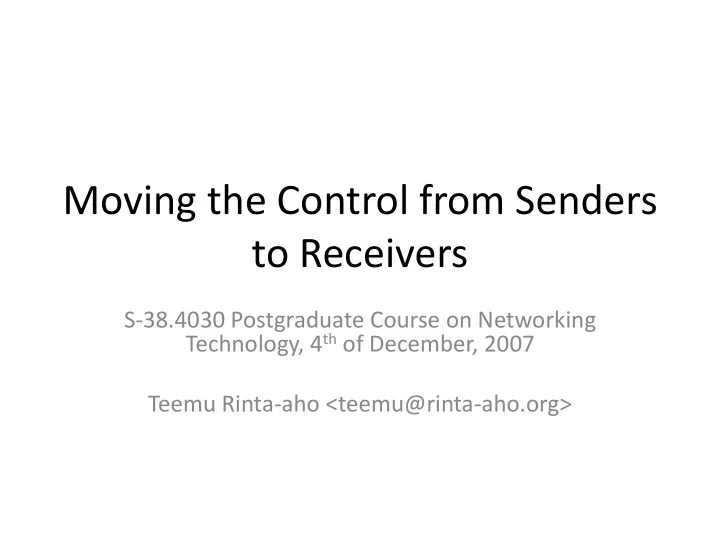

Moving the Control from Senders to Receivers S-38.4030 Postgraduate Course on Networking Technology, 4 th of December, 2007 Teemu Rinta-aho <teemu@rinta-aho.org>
Contents • Background • Publish-Subscribe internetworking • Prototype • Conclusions
Background • Most networks of today are built on the send-receive model – Sender selects the receiver (e.g. IP address) – Network helps the sender (routing by dst address) • One alternative is the publish-subscribe (PubSub) model – Receiver selects what it wants to receive (data ID) – Network helps the receiver (routing by data IDs) • The research question: – Try to see if it is possible to implement an internetworking architecture on top of the publish-subscribe model instead of the send-receive model
PubSub Internetworking: Why? • Micro-economics: Prevents DDoS very effectively – sender does have incentive to send, always – receiver does not necessarily have incentive to receive – current networks help the sender • network forwards whatever senders send • “rendezvous” takes place at the receiver, with the receiver’s resources • Fundamentals: How could the network help receiver? – by allowing the receiver to select what to receive • Architecture: Unifies unicast and multicast from the beginning – unicast becomes a 1-recipient multicast – makes radio and wireline more similar • Applications: More natural to many applications – content delivery networks
IP vs. PubSub Internetworking Sender Publisher Sprouter PubSub network IP network #¤&)==&”?# SPAM!!! DoS!!! Subscribe Receiver Subscriber
Architectural Components • Identifiers • Primitives • Publication metadata • Compensation mechanisms • Authentication mechanisms • Rendezvous, routing and forwarding
Identifiers • End-points are not identified, only data – Publisher may have an ID • Not bound to a location • Publication ID – Private, a.k.a. ”The Private Key of the Publication” – E.g. a hash over the data+a public key+... • Subscription ID – Public, a.k.a. ”The Public Key of the Publication” – E.g. a hash of the Publication ID
Primitives • publish – Publish data and associated metadata – E.g. Publish a file or a stream • subscribe – Subscribe to a publication – Breaks down to publishing a subscription
Publication Metadata • Data needed to handle a publication – Not application data – Contains e.g. • Publication ID • Subscription ID • Scope • Related compensation mechanism
Compensation Mechanisms • Needed to build a new marketplace where publishing and subscribing have a price • In the core of the network, not a per- application solution • Mechanism may vary from basic authentication (home WLAN) to business agreements (between ASes) • Effective method to reduce the SPAM and DDoS problems?
Rendezvous, routing & forwarding • Rendezvous – How subscription and publication are matched? – If IDs are flat, then maybe a DHT solution • Routing – Based on multicast delivery trees that are pre- built • Forwarding – Configured by routing
Functional model Subscribe(Id Sub ) Publish(Id Pub ) Pu Sub H b H R R R R Sub H H Subscribe(Id Sub )
Three-layer architecture Rendezvous: Routing: Maintain publication Make routing decisions, information, find the right how to build a route from publication when the publications location to subscribed the subscriber R H H R R F R F Forwarding: Efficiently deliver data from the current location to R R the subscriber. R R F F H H
Prototype • A prototype implementing a publish-subscribe type of communication interface between applications • Implemented completely in Linux userspace • Everything above link layer implemented ”from scratch” • Stack internally using pubsub-type approach – No ”vertical stack”: applications and network managers using the same ”blackboard” • Currently running over Ethernet – Practical to implement – Ethernet addresses are ignored – Using Ethernet as a broadcast channel
Prototype (2) • Currently implemented – Publishing and subscribing of static files – Simple rendezvous, routing and forwarding – Fragmentation support • Future – Compensation mechanisms – Inter-domain RRF – Support for all types of applications (stream,...) – Unifying file system and networks
Prototype Architecture Application PSD Application PSD R W R W libpcap libpcap liberator libnet liberator libnet disk disk NIC NIC Ethernet
Conclusions • PubSub vs. send-receive – Huge change in thinking regarding networking • PubSub internetworking architecture – First ideas – 1st prototype up and running • PSIRP EU project starting in 2008 – P ublish- S ubscribe I nternet R outing P aradigm – 8 partners, 2.5 y, 335 MM, 2.6 M € EU contribution – Everything from link layer to application layer • The work has just begun... – More open questions than answers
Questions? Thank you!
Recommend
More recommend